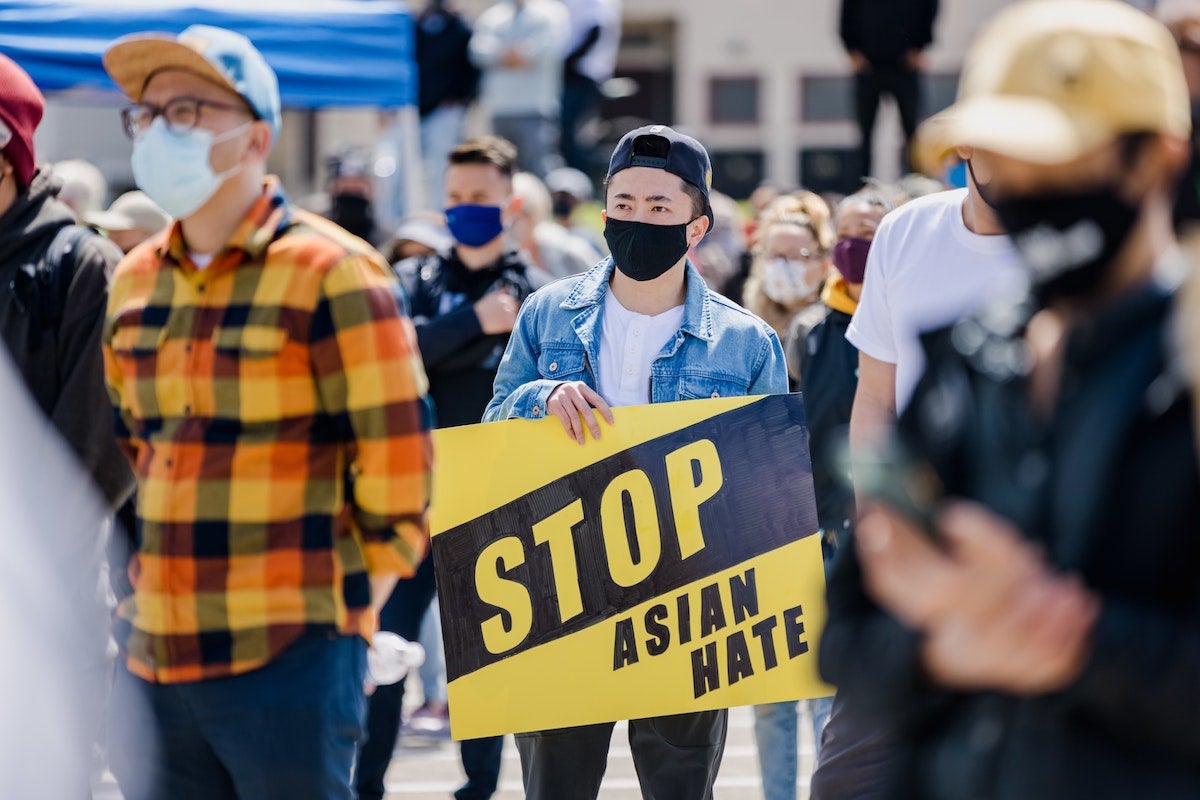As anti-Asian incidents have increased during the pandemic — with nearly 3,800 U.S. reports to the Stop AAPI Hate nonprofit from March 2020 through February 2021 — recent American history is reflecting roots of Asian American racism.
It’s important to understand how we got here and the longstanding history of Asian American racism in this country.
Christian Ravela, an assistant professor of philosophy who specializes in race, cultural and Asian American studies, provides some context on racism that dates back to the beginning of Asian individuals’ migration to the United States during the 1800s.
Economic-related Resentment
“Asian Americans have often figured as a scapegoat in periods of economic anxiety and that has precipitated anti-Asian violence,” Ravela says. “A recent example would be the murder of Vincent Chin in 1982 by two Detroit auto workers. Part of the economic anxieties that were happening there was the fear of Japanese competition for the U.S. economy.”
Chin, a Chinese American, was out celebrating his bachelor party crossed paths with Chrysler plant supervisor Ronald Ebens and his stepson Michael Nitz, who was recently laid off. The two assumed he was Japanese, used racial slurs and attacked Chin out of resentment toward the successes of Japanese auto companies. Although Chin was immediately rushed to a hospital, his injuries were so bad that medical workers doubted he would recover, and he died four days later. Ebens and Nitz pled guilty to manslaughter, paid a $3,000 fine and served three years of probation, while denying the crime was racially motivated.
“Asian Americans have often figured as a scapegoat in periods of economic anxiety and that has precipitated anti-Asian violence,” — Christian Ravela, associate professor of philosophy
But employment-related contempt for Asian Americans can be seen from the beginning of the population’s immigration to the United States. In the 1850s, the first major wave of Chinese immigrants came to the U.S. as laborers who significantly contributed to mining, farming, fishing, and railroad workforces, with the Gold Rush and construction of the first transcontinental railroad as two major opportunities. As they found success — particularly in California with Chinese immigrants making up 20% of the state’s labor force by 1870 despite only accounting for .002% of the national population — according to the Center for Global Education at Asia Society, they became targets and the racist concept of “Yellow Peril” began to emerge, which positions people from East Asia as a threat to the Western world.
During this time a series of laws that restricted the civil rights, educational access, culture and livelihood of Asian Americans were passed and eventually laid way for the Chinese Exclusion Act of 1882 — marking the first federal law to target an ethnic group and restrict immigration to the United States. It halted Chinese immigration for 10 years, with few exceptions, and made current residents ineligible for American citizenship. It was extended for about 50 years through the Geary Act of 1892 until it was repealed by the Magnuson Act in 1943, which allowed 105 Chinese immigrants to enter each year and for current residents to apply for citizenship.
The Geary Act not only extended immigration restrictions, but also required that the Chinese carry a resident permit. If an individual didn’t have a permit, they could face deportation or a year of hard labor. Since 1854, Chinese Americans were banned from testifying in court after the California Supreme Court overturned the murder conviction of a white man that was based on the testimony of Chinese witnesses. This restriction began to loosen in 1882, however under the Geary Act Chinese Americans could not bear witness in court proceeding related to their detention and could only receive bail if two “credible white witnesses” would testify on their behalf.
The Model Minority Stereotype
This need for approval from white people and to be seen as “real” Americans contribute to what’s known as the model minority stereotype, which paints Asian Americans as educated, successful, and obedient individuals who have risen above discrimination through hard work. Not only does this stereotype unfairly identify Asian Americans as monoliths, it dismisses race-related obstacles many have had to struggle with. The model minority stereotype is also rooted in anti-Blackness, as it’s usually used to perpetuate negative stereotypes against African Americans and condemn them for speaking out or protesting against social issues.
“Part of the assumptions about the model minority myth is [Asian Americans] don’t also experience spectacular forms of violence,” says Ravela. “But during the 19th century, there are many instances of anti-Asian violence that happened specifically on the West Coast, because that’s where the mass migration of Asians was happening. There were lynchings of Chinese in Los Angeles. There were race riots in areas like Bellingham, Washington. There were various forms of anti-Asian violence that were really endemic and prolific during that period.”
“Part of the assumptions about the model minority myth is [Asian Americans] don’t also experience spectacular forms of violence.” — Christian Ravela, associate professor of philosophy
In 1886, mobs burned down at least a dozen Chinatowns in California to the ground. When a Chinese American was suspected to have died from the bubonic plague in 1900, San Francisco police allowed white people to leave Chinatown but quarantined Asian Americans. The area was enclosed with barbed wire and officials discussed burning down the 16 blocks. While the fire was never set in San Francisco, residents in Santa Ana, California, and Honolulu burned down areas where infected people lived, leaving thousands of people homeless.
As Asian Americans pushed for greater acceptance, they began to get it after World War II, largely because the United States wanted to protect its image as a world power. But this didn’t happen until after more than 120,000 Japanese residents — with the majority being U.S. citizens — were forced into internment camps for four years following the 1941 Pearl Harbor bombing out of fear these individuals were working against the United States.
“In the mid-20th century the United States is … trying to demonstrate a kind of moral authority to lead the emerging international order,” Ravela says. “During World War II, the Japanese empire would point to the racism in the U.S. and [later] during the height of the Cold War the problem of racism was always there. Other countries, such as the Soviet Union, questioned, ‘How can you claim to be this great liberal democracy when you have domestic racism all over the place?’ So during that period there was a need to try to stifle and undercut these claims by international forces.”
Discrimination Throughout Diversity
During the civil rights movement, the Immigration and Nationality Act of 1965 removed racial- and ethnic-based restrictions for immigrants. This policy shifted the demographic makeup of America as more Asian and European immigrants came to the United States.
“The composition of Asian migration changes radically after 1965, so that you get a bifurcation in it where there are more highly educated Asian immigrants coming to the U.S.,” Ravela says. “They’re wealthier as a result of these changing policies, but they’re also at the same time, a lot poorer Asian immigrants as well, who come by slightly different means, such as refugees from the wars.”
Between 2000 and 2015, the Asian American population grew by 72% to 20.4 million, marking the fastest growth rate of any major racial or ethnic group, according the U.S. Census Bureau. Within the wide range of cultures of Asian Americans, Chinese, Indian and Filipino individuals make up the largest groups, while Bhutanese, Nepalese and Burmese populations are the fastest growing.
“It’s really important to talk about the diversity of Asian Americans — and the historical legacy of that term is related to political activism, but people question its value. What it obscures is the incredible diversity of what is Asian America, which comprises more than 30 ethnic groups that come from so many religious traditions … and many class differentiation across those groups,” Ravela says. “Part of the persistent notion about the model minority stereotype is the assumption about an ultra-wealthy, crazy-rich Asian image of what Asians are. But Asian Americans are also some of the poorest communities, such as Hmong refugees or certain Laotian communities, and that’s really due to the different histories of arrival and settlement into the U.S.”
After 9/11, for example, South Asians, in particular, were under attack as Islamophobia was on the rise. In 2000, there were 12 reported anti-Muslim attacks in the United States, according to FBI data. In 2001 the attacks grew to 93. The center also found that anti-Muslim attacks have spiked in recent years, with 127 reported attacks in 2016, an about 40% increase from the year before.
“The story of the model minority stereotype is still pertinent but also has limitations for understanding Asian American life today.” — Christian Ravela, associate professor of philosophy
“The story of the model minority stereotype is still pertinent but also has limitations for understanding Asian American life today,” Ravela says. “The example of South Asian Muslims and Sikhs being racialized as ‘terrorists’ marks a different formation of Asian American racialization from the ‘model minority.’ At the same time, they are connected in a broad sense in terms of how Asian American racialization are expressions and indicators of U.S. geopolitical and economic anxieties and concerns.”
Asian Americans are projected to become the largest minority group in the United States by 2055, according the U.S. Census Bureau. With this rise in population, there is a potential for the already increased anti-Asian hate crimes to increase, if the nation doesn’t learn and unlearn from its past.
“The history and knowledge of various ethnic racial groups is not something that’s readily taught here [in the United States] or part of the usual curriculum at the K-12 level. It’s not something that gets often portrayed in terms of its rich diversity within popular culture,” Ravela says. “Learning about Asian American history is essential to combat racism. Such knowledge undercuts the naturalization of Asian stereotypes in the U.S., specifically highlighting the political, economic and social conditions and power dynamics that give rise to such Asian racial stereotypes. More than this, I would say studying Asian American history and experience can give one insight into the history of race and racism in the U.S. in general — not only how race and racism are relationally constructed within and outside of a Black-white binary but also forged both domestically and abroad by the U.S.”





